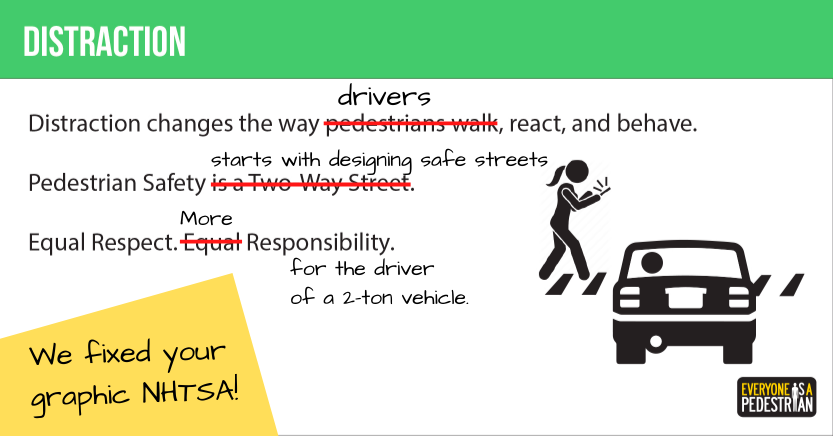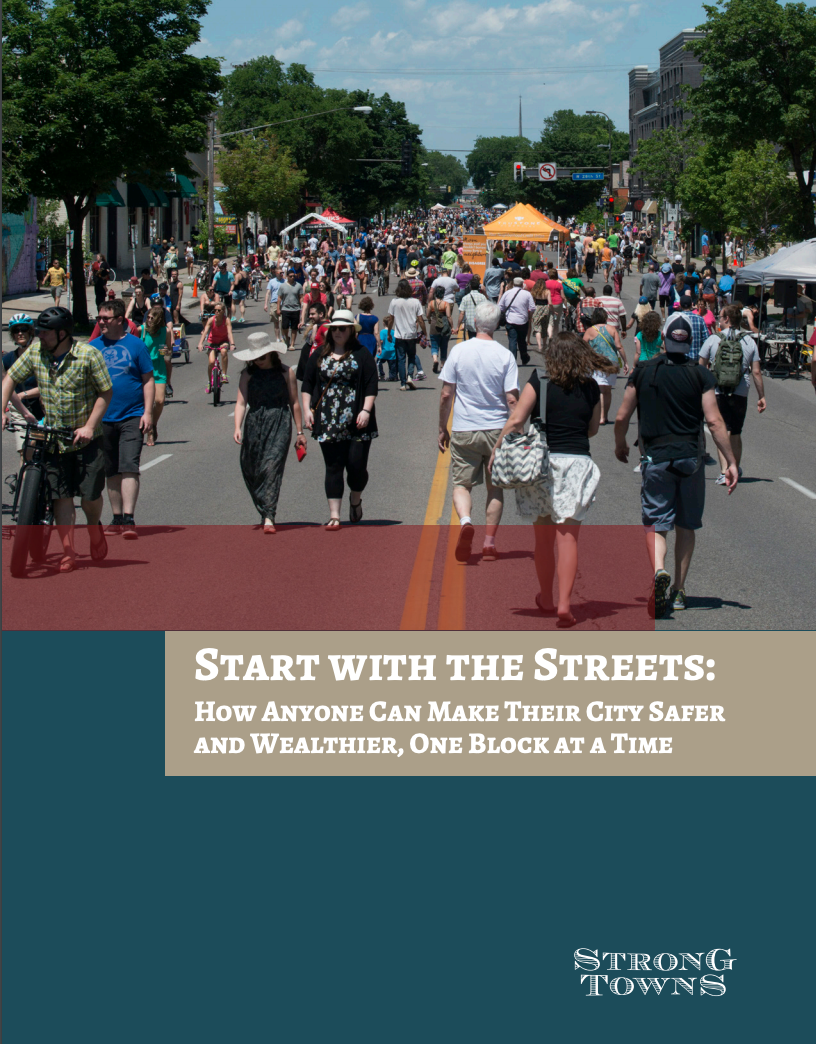Taking Pedestrian Safety Into Our Own Hands
.@NHTSAgov decreed October to be the first ever “Pedestrian Safety Month.”
— Transportation for America (@T4America) October 8, 2020
Yet NHTSA’s pedestrian-blaming “playbook” MASSIVELY misses the point & completely excludes people with disabilities. Let’s discuss, & then hear from you on how to improve it. https://t.co/Oczc5xE4c5 pic.twitter.com/LNztcGwH0j
The National Highway Traffic Safety Administration (NHSTA) has designated October as its first-ever Pedestrian Safety Month. Part of the Department of Transportation, the NHTSA is, in its own language, “responsible for keeping people safe on America’s roadways.” Though there were reasons to be skeptical, let’s give the NHSTA the benefit of the doubt and say that a Pedestrian Safety Month could have done some good. A federal agency whose mission it is to save lives, prevent injuries, and reduce the economic costs of road traffic crashes “through education, research, safety standards, and enforcement,” should have a lot to say about the most effective way to protect pedestrians—designing our roads for safety.
Alas, what we got was more of the same: victim-shaming, distraction from real solutions, and, as our friends at Transportation for America tweeted, a spectacular exercise in missing the point.
The NHTSA released a “Pedestrian Safety Month Playbook” that takes communities through a four-week, seven-issue calendar. They provide sample press releases, links to additional research and resources, suggested enforcement strategies, and sample social media graphics. The safety concerns “addressed” in the playbook include decreasing vehicle speed, walking to and from school, distracted driving and walking, impaired pedestrians, illegal school bus passing, older pedestrians, and Daylight Saving Time. The playbook is aimed at both pedestrians and motorists, “because pedestrian safety is a two-way street that involves equal respect and equal responsibility.”
Transportation for America corrected a graphic from the Pedestrian Safety Month Playbook. Image source: Transportation for America
In that recent Twitter thread, Transportation for America did a great job highlighting the playbook’s critical shortcomings. In addition to pedestrian-shaming, the NHSTA playbook excludes people with disabilities, promotes walking to school but doesn’t acknowledge that many children don’t live in safely walkable neighborhoods, and advises drivers to follow the speed limit while ignoring the fact that many roads are designed for speed and that speed limits are often too high. (“A ‘Pedestrian Safety Month’ that doesn’t focus on street design does more harm than good.”) Transportation for America also reminds us how ludicrous it is that “the person walking and the person operating a 5,000 lb vehicle have equal responsibility to ensure road safety.” See their ”fixed” NHTSA graphic at left.
Strong Towns member and frequent contributor Joe Cortright also had some fun with the NHTSA’s Pedestrian Safety Month. State and federal departments of transportation spend billions building and expanding roads with the goal of speeding traffic—an often futile undertaking—while fighting safety problems with P.R. campaigns (see, for example, Captain Vision Zero, a superhero-themed safety campaign in San Diego). Joe’s suggestion: “Let’s fight traffic congestion using the same techniques DOT’s use to promote safety. Let’s have costumed superheroes weigh in against congestion, and spend billions on safety, instead of the other way around.” He explains:
There’s a profound disconnect in transportation policy: When it comes to fighting congestion, highway departments spare no expense. They’ll [write] billion dollar checks to widen a mile or three of urban freeway in the name of speeding traffic (if only a little bit and for a short time). But when it comes to safety those same highway departments turn stingy, and manage only to find a few pennies, mostly for sanctimonious and ineffectual public service announcements….
So here’s today’s modest proposal: Let’s turn those priorities around. Let’s have highway departments use marketing campaigns to fight congestion, and spend real dollars on improving safety. Let’s have a potent message of personal responsibility when it comes to commutes and congestion, and make moving the needle on traffic deaths and injuries the arbiter of where we spend transportation system dollars.
Joe, who runs the Portland-based think tank City Observatory, is a reliable source for pointing out the absurdities of pedestrian safety efforts that don’t address the underlying cause—namely, the way we’ve optimized our cities for vehicles, while making our communities “less safe and less desirable for humans who are not encapsulated” in two tons of steel. Back in 2018, Joe proposed the idea of giving pedestrians personal airbags or rocket packs. (There are drawings.)
In the end—and Joe Cortright and the folks at Transportation for America would agree—there’s nothing funny about how dangerous our roads are. As we’ve written elsewhere, neighborhood streets with wide lanes, huge clearance zones and other dangerous design features cause thousands of pedestrian and car passenger deaths every year. (This is in addition to making our communities less economically productive and less healthy.)
It’s time to design our streets for safety and slow the cars. The federal government isn’t coming to do it for us, so we’ll need to take matters into our own hands. Here are a few Strong Town articles that can help you do just that:
1. “Now Is the Time to End Traffic Fatalities. Here's a Simple Plan to Do It.” by Charles Marohn
We’ve engineered our streets for high performance when we should be engineering them for safety. Now’s the time to unwind the mess. Here’s how to do it. Read more…
2. “Yes, Your Tactical Urbanism Project Can Save Lives, Too.” (Podcast)
Strong Towns member Austin Taylor—Parking and Sustainability Coordinator for Provo City, Utah—shares how you can use tactical urbanism to create safer streets, including how to plan your intervention, how to get local government involved, and how to use your intervention to create lasting change. Read more…
3. “Pointing hair dryers at speeding drivers, toilet plunger bike lanes, and more unconventional yet effective ways to #SlowTheCars,” by Kea Wilson
Until communities get serious about slowing the cars, pedestrians will continue to take safety into their own hands…often in very creative ways. Read more…
4. “Slowing the Cars in St. Louis,” by Marielle Brown
Marielle Brown undertook an impressive tactical urbanism project in the city of St. Louis to help make streets safer. Watch how a simple and cheap traffic-calming project made a big impact on neighborhood safety and productivity. Read more…
5. “The human side of traffic calming (or how I learned to stop worrying and love disorder),” by Marielle Brown
The success of programs around the world that deliberately add disorder to public streets is a strong refutation of the U.S.’s conventional approach to street design. Read more…
6. “3 Ways to Make Streets Safer for Pedestrians,” by Adam Porr
Pedestrian activity is an indicator of vibrant neighborhoods and a healthy local economy. How can we transform our streets so that pedestrians feel safe and drivers are attentive and courteous to their needs? Read more…
7. “Two Photos Reveal Why the Key to Slowing Traffic is Street Design, Not Speed Limits,” by Daniel Herriges
Two simple photos show the difference between a street simply designated 20 miles per hour, and one actually designed to be safe. We can't regulate our way to safety. Read more…
8. “The Ultimate Guide to Creating Walkable Streets,” by Rachel Quednau
The ultimate guide to building slower, more walkable streets, filled with helpful articles and resources you can use to #SlowTheCars in your town. We've broken it down into four key sections that will explain why we need walkable streets, how to tell if your streets aren't walkable, and resources for building walkable streets, plus inspiring stories that will demonstrate how to build safer streets. Read more…
9. Start with the Streets (free ebook)
This book—created by leaders in the Strong Towns movement—will show you why slower streets create more prosperous and safe communities for everyone. You’ll learn why walkable, people-oriented streets are the most economically productive form of development we can choose for our communities, and why better design—not ticketing or speed limits—is the only way to truly achieve that goal. You have the power to build a strong town. We can’t wait to see what you’ll accomplish. Download right away…
Cover image via City Observatory
Help grow the movement to build stronger, safer, and more financially resilient cities by becoming a member today.




John Pattison is the Community Builder for Strong Towns. In this role, he works with advocates in hundreds of communities as they start and lead local Strong Towns groups called Local Conversations. John is the author of two books, most recently Slow Church (IVP), which takes inspiration from Slow Food and the other Slow movements to help faith communities reimagine how they live life together in the neighborhood. He also co-hosts The Membership, a podcast inspired by the life and work of Wendell Berry, the Kentucky farmer, writer, and activist. John and his family live in Silverton, Oregon. You can connect with him on Twitter at @johnepattison.
Want to start a Local Conversation, or implement the Strong Towns approach in your community? Email John.